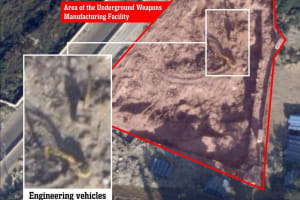Russia and Iran to build drone factory in Russia
Iran blames Israel for the Jan. 28 drone attack on the Isfahan munitions-production facility

Russia and Iran are planning to build a drone factory in Russia, according to a recent Wall Street Journal report.
The factory would be able to manufacture at least 6,000 drones for Russia to use in its war on Ukraine that began last February.
According to the WSJ report, the intel comes from officials of a country aligned with the United States and follows a warning from the White House in December that Iran and Russia were considering collaborating on building a drone production facility.
The report stated that a delegation of Russian and Iranian officials visited the town of Yelabuga, about 600 miles east of Moscow, on Jan. 5, led by Brig. Gen. Abdollah Mehrabi, head of the Islamic Revolutionary Guard Corps Aerospace Force Research and Self-Sufficiency Jihad Organization, and Ghassem Damavandian, the chief executive of Qods Aviation Industries, which manufactures most of Iran’s drones.
According to the report, the factory is expected to manufacture an updated version of the Shahed-136 autonomous suicide drone that Russia has been using against Ukraine.
The Shahed-136 is a slow-moving, noisy pusher-prop drone and Ukrainian forces have successfully shot down many of them before they reached their targets. The updated version of the drone would have a new engine capable of flying faster and farther.
While construction of the factory and the upgraded drone has not yet started, U.S. officials are concerned about the increasing cooperation between Russia and Iran.
Russia repeatedly denies using Iranian drones against Ukrainian targets. Last year, Iranian Foreign Minister Hossein Amir-Abdollahian acknowledged that Iran had sent drones to Russia. He claimed, however, that it was done before the start of the conflict in Ukraine.
Both Iran and Russia have faced crippling sanctions from the U.S. and Western allies over the Russian-Ukrainian conflict and Iran’s role in such conflicts throughout the Middle East. The strengthening ties between the two countries, including a decision to integrate their banking systems in January, show that Iran and Russia are opting to strengthen each other, rather than stopping the behavior that led to the sanctions.
This latest move seems to show the two countries doubling down. At this point, it is not clear that further sanctions would change either country’s trajectory.
In November, Western officials warned that Iran could transfer ballistic missiles to Russia. These missiles would allow Russia to overwhelm Ukrainian air defenses and would also constitute a serious, provocative stance towards Europe’s NATO alliance members.
In December, The New York Times reported that the Biden administration was trying to stop Iran from supplying drones to Russia and toward that effort, was “engaging an ally with a long history of undermining Iran’s nuclear program: Israel.”
Several international intelligence agencies attributed the Jan. 28 drone attack on Iran’s Isfahan munitions-production facility to Israel. Iran also blamed Israel for the attack.
Israel did not comment on the attacks, per military protocol.

The All Israel News Staff is a team of journalists in Israel.














